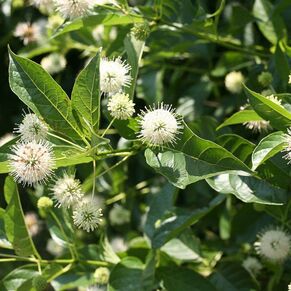 Buttonbush Buttonbush By Simon May With Spring right around the corner, many of our neighbors with a green thumb are excited to start planning their gardens for the fair weather seasons. An important part of landscaping is incorporating native plants to ensure that pollinators, birds, and “good bugs” are welcome in our area. Many people are familiar with the Indiana native purple cone flower, yellow black-eyed susan, and blue Siberian iris, but here are some not-as-well-known options that are easy to grow in the Indiana climate. Aromatic Aster: This showy, mounding perennial is a great option for dry areas of your landscape with rocky or sandy soil that drains well where you want to add a pop of late summer or early fall color that will keep the bees fed as the weather turns. After the summer blooms are spent, this blanket of rigid stems springs to life with pink to lavender-blue many-petaled flowers with an aromatic yellow center. Since the flowered stems can grow too tall (10-20”) and heavy for their own good, they may open up or fall into a less desirable shape, so a peony cage may be used or simply keep the mound thick by pruning it back by no more than half in June. This plant does spread by stolons or runner roots, so thin it regularly to control the size of the mound. Cardinal Flower: This perennial is for the hummingbird lovers as they are the primary pollinators of this plant along with butterflies. Cardinal Flower may be grown in full sun to shade, but moisture is a must as they cannot tolerate drought, so if planting in sun anticipate mulching and frequent watering. The showy red blooms that can rise 3-6’ tall are named after the bright red robes worn by Roman Catholic cardinals, not the state bird. This plant propagates by seed which can be collected at the end of the season for refrigeration, or the seed heads can be cut off to control spreading. Shooting Star: This distinctively flowering plant is among the likes of bleeding hearts or columbine in my book, something that looks strange and will make people ask “What is that?” The shooting star plant is a woodland species (part shade) that has been cultivated and become commercially available, benefitting bees and other pollinators. The leafless flower stalk arises 6-20” from a cluster of bright-green leaves. At the top, the stalk divides into arching branches, each terminating in a downward nodding flower with strongly-backward pointing white or deep pink petals forming star patterns in a cluster. Truly and unusually beautiful, these add a pop of early summer color to a shady area with moist rocky or sandy soil. Best propagated by division, similar to hostas. Common Buttonbush: This perennial shrub is a shade or part shade loving plant that can spread and grow up to 6-12 feet after several seasons, so give it some room. It can also be trained into a tree shape. Great for a wet area of your landscape that does not drain well, this shrub loves to have its feet wet and it’s leaves cool. The long-lasting, distinctive blossoms are usually white or pale pink with a fringe of pistils protruding out that resemble a pin cushion and attract butterflies, nectar bees, and birds in the fall who will eat the persisting nutlets within the blossom. Clematis Virginiana: This perennial climbing vine is very versatile as it can thrive in full sun to part shade on trellises or along fences. Most clematis are prized for their large flat flowers, but this clematis, also known as the Virgin’s Bower, produces small clusters of delicate white flowers that attract bees and other pollinators. This variety is also unusual because it blooms in the late summer or early fall. In the late fall, the flowers will transition to seed heads that look like beautiful swirling clouds. These are easily removed if you’re worried about spreading. It is important to purchase this plant from a greenhouse and not source it naturally since there are some invasive varieties. If you try any of these plants in your garden, please send pictures to the Historic South Wayne Neighborhood Association Facebook page for us to share. Happy gardening! Simon May has lived much of his life in the '07 and currently resides on Kinnaird with his husband, Richard, and their four dogs. He is a lifelong gardening hobbyist, by no means an expert, whose love of plants, flowers, and the outdoors was fostered by his master-gardener mother and his father who came from a family of farmers. Comments are closed.
|
Archives
May 2024
|

 RSS Feed
RSS Feed
